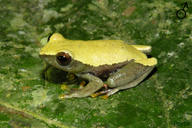|
Hyperolius bolifambae Mertens, 1938
| family: Hyperoliidae genus: Hyperolius |
 © 2017 Daniel Portik (1 of 36) |
|
|
|
Description This species is similar to H. pardalis and a subspecific relationship or synonymy has been suggested. Amiet has studied the two species in the field and demonstrated that they are distinct species with different calls, partly sympatric. Distribution and Habitat Country distribution from AmphibiaWeb's database: Cameroon, Central African Republic, Congo, the Democratic Republic of the, Gabon, Nigeria
Life History, Abundance, Activity, and Special Behaviors Comments This account was taken from "Treefrogs of Africa" by Arne Schiøtz with kind permission from Edition Chimaira publishers, Frankfurt am Main.
References
Schiøtz, A. (1999). Treefrogs of Africa. Edition Chimaira, Frankfurt am Main. Originally submitted by: Arne Schiøtz (first posted 2001-01-10) Edited by: Kellie Whittaker (2008-09-10) Species Account Citation: AmphibiaWeb 2008 Hyperolius bolifambae <https://amphibiaweb.org/species/510> University of California, Berkeley, CA, USA. Accessed Nov 12, 2024.
Feedback or comments about this page.
Citation: AmphibiaWeb. 2024. <https://amphibiaweb.org> University of California, Berkeley, CA, USA. Accessed 12 Nov 2024. AmphibiaWeb's policy on data use. |



 Map of Life
Map of Life